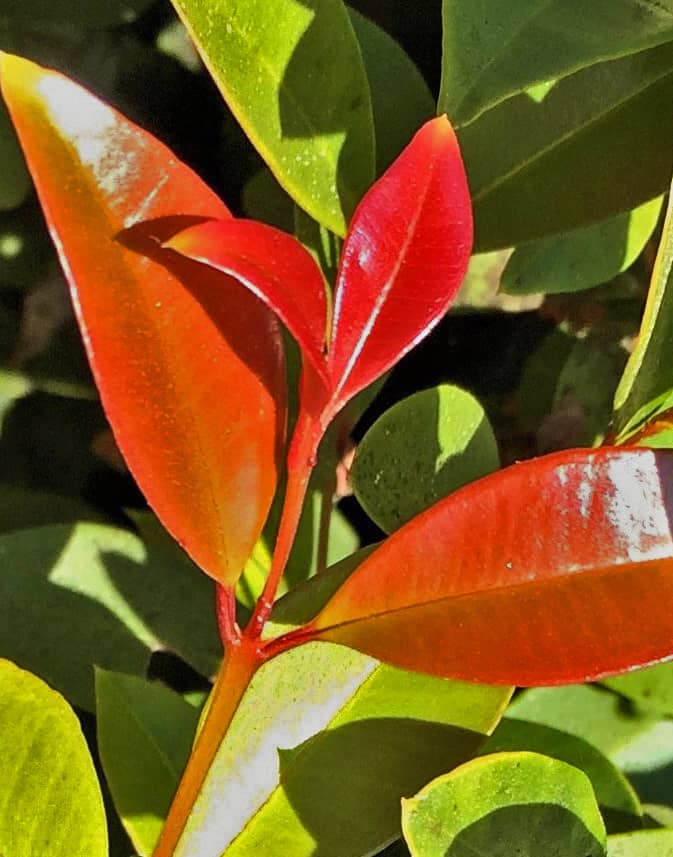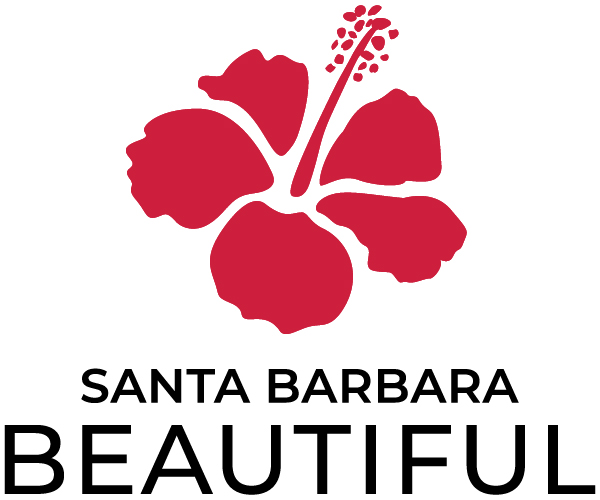Santa Barbara Beautiful Tree of the Month – November 2020

Syzygium australe
You might be thinking – “Wait a minute – Eugenia isn’t a tree – it’s a hedge!” Well, you would be partly right, because Eugenia is one of the most versatile plants in cultivation; it can easily be pruned into several forms: a tree, a shrub, or a hedge.
Eugenia has been grown in Santa Barbara since the 1880s. In its tree form, it has been planted and maintained by the City on many of our streets and in our parks. In its hedge form, it has been planted and maintained by a multitude of homeowners to outline and/or screen their yards and gardens. After all these years, over one hundred mature Eugenia trees grace our community – and there are more Eugenia hedges around town than we can count!
The largest Eugenia tree in California, as listed in the California Big Tree Registry, stands on the grounds of the historic Stow House in Goleta. This arboreal giant is over 140 years old, reaches more than 70 feet tall, carries a canopy spread of over 60 feet, and has a trunk diameter of almost 5 feet. It certainly is a tree!
Eugenia is usually considered a small- to medium-sized broadleaf evergreen tree. Its crown is pyramidal in shape when young, and with age becomes broad and round with limbs that have graceful pendulous ends. In our climate, it grows at a rate of about 12 inches a year, reaches a height of 30 to 50 feet, and could live for at least 150 years.
Certainly, its most distinctive feature is its new foliage, which sprouts out a remarkably bronze-red to purple color. As the lanceolate-shaped leaves (1- to 3-inches long and 1/2 to 1-inch wide) mature, they become a dark, shiny, green and fill in densely. A young tree has bark that is light-beige with shallow furrows; as it matures, this will change to a dark gray with light-brown underneath.
In the summer months, Eugenia has delightful, creamy-white, flowers (1/2 inch diameter), which appear in terminal cymes at or near the ends of branches, often in clusters of 3 to 7. These are “perfect” flowers (meaning that each flower has both male and female sexual parts). Upon close examination, each bear numerous long stamens (male parts) that end in yellow-tipped anthers of pollen, with the result that the entire flower looks, amazingly, like a tiny ball of fiber optic lights. When in full bloom, a Eugenia will resound with the buzz of feasting bees.
In the fall, pollinated flowers develop into fruits (averaging ½ inch in diameter) that change color from pinkish magenta into deep purple as they ripen. The fruit is quite edible and has a flavor and texture somewhat like sour apples. It can be eaten either fresh or cooked into jams. Many birds find the fruit delicious – and, consequently, spread the seeds widely.
Although the fruit is attractive on the tree, after it falls to the ground it does cause maintenance concerns, due to the sheer abundance of messy fruit underfoot and the purple stain of the juice. Hedging will remove most of the flowers and, thus, greatly reduce fruit litter.
Eugenia lost some of its popularity in America in the late 1980’s when we experienced an infestation of an invading psyllid, a sap-sucking winged insect about the size of an aphid, with the formal name of Trioza eugeniae. This destructive psyllid deforms Eugenia leaves and, in severe cases, causes defoliation. Most of the damage results from the psyllid larva, which create ugly galls that pit and dimple the leaves – and leave behind honeydew spots that soon develop black sooty mold.
Fortunately, the infestation was largely combatted through research efforts conducted at UC Berkeley, which determined that tiny eulophid wasps (Tamarixia) naturally parasitize the psyllids. In the 1990s, the importation of these helpful wasps from Australia and their wide release in California solved the problem in most areas, without the use of pesticides. Biological warfare at its best! In addition, the regular shearing of Eugenia hedges – and leaving the clippings as mulch underneath – will keep them generally pest-free and will encourage the formation of the colorful new foliage.
Eugenia is very adaptable to pruning, so, in addition to being planted as a hedge, it is frequently trained for topiaries, espaliered on walls and trellises, and used as a bonsai. There are named cultivars selected specifically for dwarf and/or compact growth habit and for psyllid resistance.
Eugenia, in any of its forms, does best in full sun to partial shade. When young, it will appreciate some supplemental irrigation. When well-established, it is drought hardy. It can sustain damage at temperatures lower than 25 degrees, so it should be planted in almost frost- free or protected areas. It prefers deep loamy soil but will do quite well in clay and sandy soils.
Eugenia is native to coastal rainforests of eastern Australia, which is why it does better with supplemental irrigation. The botanical name for Eugenia is Syzygium australe. The genus name, Syzygium, is derived, via Latin, from the Greek word “syzygos”, meaning “yoked together”, referring to the Y-shaped opposite leaf arrangement. (Surprisingly, this genus includes the commercial clove (Syzygium aromaticum).) The specific epithet, australe, is derived from the Latin word “australis”, meaning “southern”, and denotes its homeland.
While its botanical name has been changed many times over the years by taxonomists, as the result of ongoing genetic research, it is still referred to primarily by its previous genus name, Eugenia. It has other reasonable common names: “Australian Brush Cherry”; “Brush Cherry”; and “Scrub Cherry”. In Australia, its common name is “Lilly Pilly”; go figure.
Mature Eugenias stand as street trees in many locations in Santa Barbara. The best examples are found on the 100 to 500 blocks of East Arrellaga Street and on the 600 to 800 blocks of West Arrellaga Street. They are also interplanted with other street tree species on the 900 to 1200 blocks of East Haley Street.
Tree-of-the-Month articles are sponsored by Santa Barbara Beautiful, whose many missions include the increase of public awareness and appreciation of Santa Barbara’s many outstanding trees and, in a long-time partnership with the City Parks & Recreation Department, the funding and planting of trees along the City’s streets – a project which has resulted in the planting, to date, of more than 13,000 street trees.
Article and photos by David Gress




